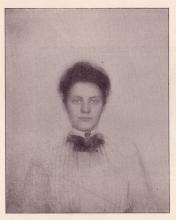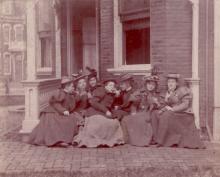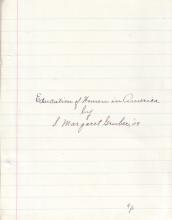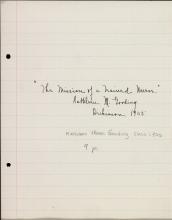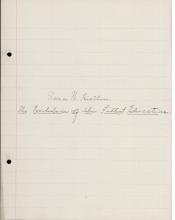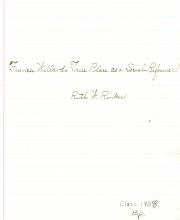From the "Hen Coop" to the "Gilded Cage"
The 1905 Microcosm includes a story abour what Dickinson College would be fifty years in the future: 1955. The Dickinson of 1955 is much different than the Dickinson of 1905. The author highlights the difference in housing for women. He wrote, "There isn't a hen coop any more. We call it the "gilded cage". The college bought the deer park you used to tell me about, enlarged the house, built a gymansium adjoining, and made everything so lovely for the girls that the fellows had to change the name."
S. Margaret Gruber's 1909 Essay "The Education of Woman in America"
In her 1909 essay "The Education of Woman in America", S. Margaret Gruber traced the history of women's education and argued that women's higher education was essential. She began her essay by discussing the history of women's education from "household drudgery" to women's higher education. She argued that women's higher education did not impare women's health but made them more vigorous. Moreover, she asserted that women who attended institutions of higher education did still marry and bear children.
Kathleen Moore Gooding's Essay "The Mission of a Trained Nurse"
In her essay titled "The Mission of a Trained Nurse," Kathleen Moore Gooding described the importance and progression of nursing in the United States. According to Gooding, prior to the nursing profession, monks and uneducated people cared for the sick. This led to much pain, sickness, and even death. However, it was not until Florence Nightingale that women became nurses and the profession took off. In closing, she highlighted the work of the Red Cross as proof of the success of the nursing profession.
Sarah H. Kistler's Essay "The Evolution of the Fittest Education", 1901
In her essay titled "The Evolution of the Fittest Education," Sarah H. Kistler analyzed the education system in the United States. She wrote that education "should be the whole system of preparation of youth for the life and work coming to the individual, to help on the pregress of the race by his influecne with, and work for , the fellow man.
Ruth W. Rinker's Essay "Frances Willard's True Place as Social Reformer"
In her essay "Frances Willard's True Place as Social Reformer," Ruth W. Rinker analyzed the life and work of Frances Willard. She argued that "In Frances Willard our age has lost one of its nobelest daughters, whose achievements for God and home and native land were such as to rank her as one of the most famous women of this century." Throughout her essay, she cited Willard's reform work in the women's ritghts and temperance movements.
Alice M. Clarkson's Essay "The Civic Movement Among Women," 1908
In her essay titled "The Civic Movement Among Women," Alice M. Clarkson analyzed women's influence in civic and reform movements of the early twentieth century. She argued that women's position as mothers in the home made them ideal candidates for social reform. She wrote, "They are the natural domestic housekeepers, and what more proper than that they should become civic housekeepers? they abate nuisances in the household. Why not in the city?" Clarkson contended that women's patience and persitence made them ideal reformers.


